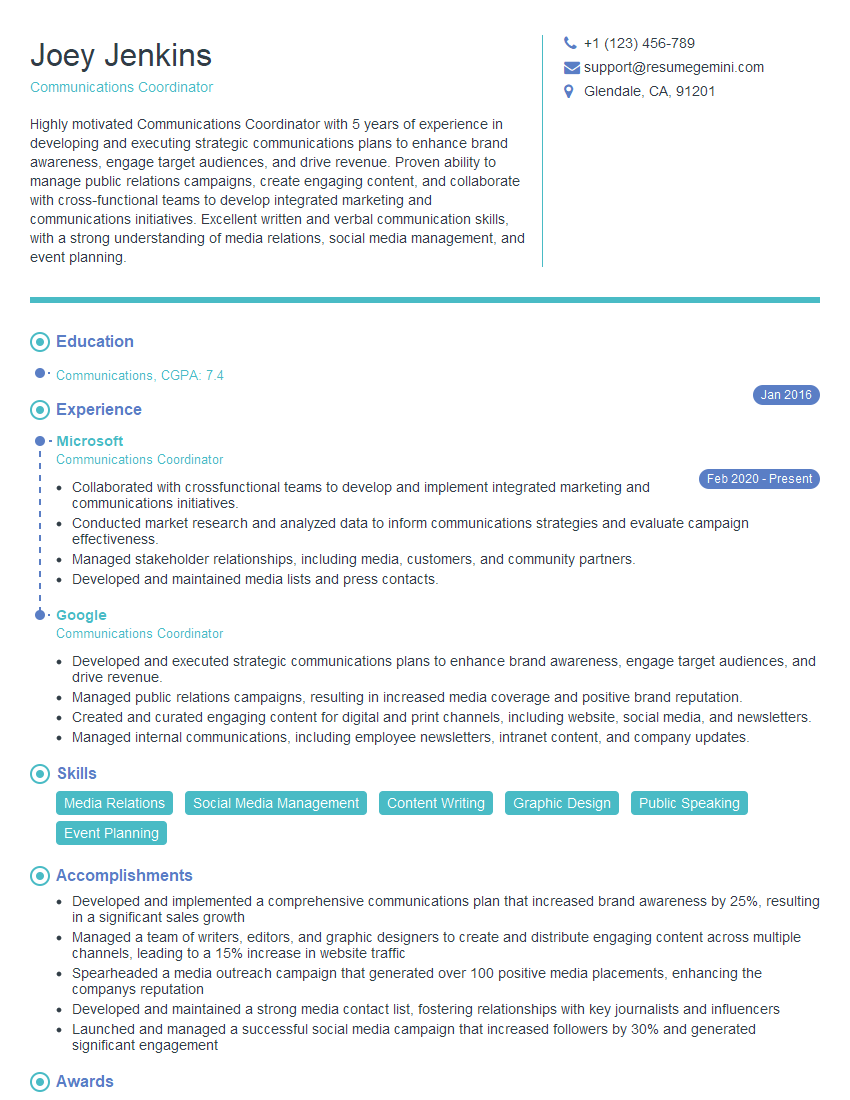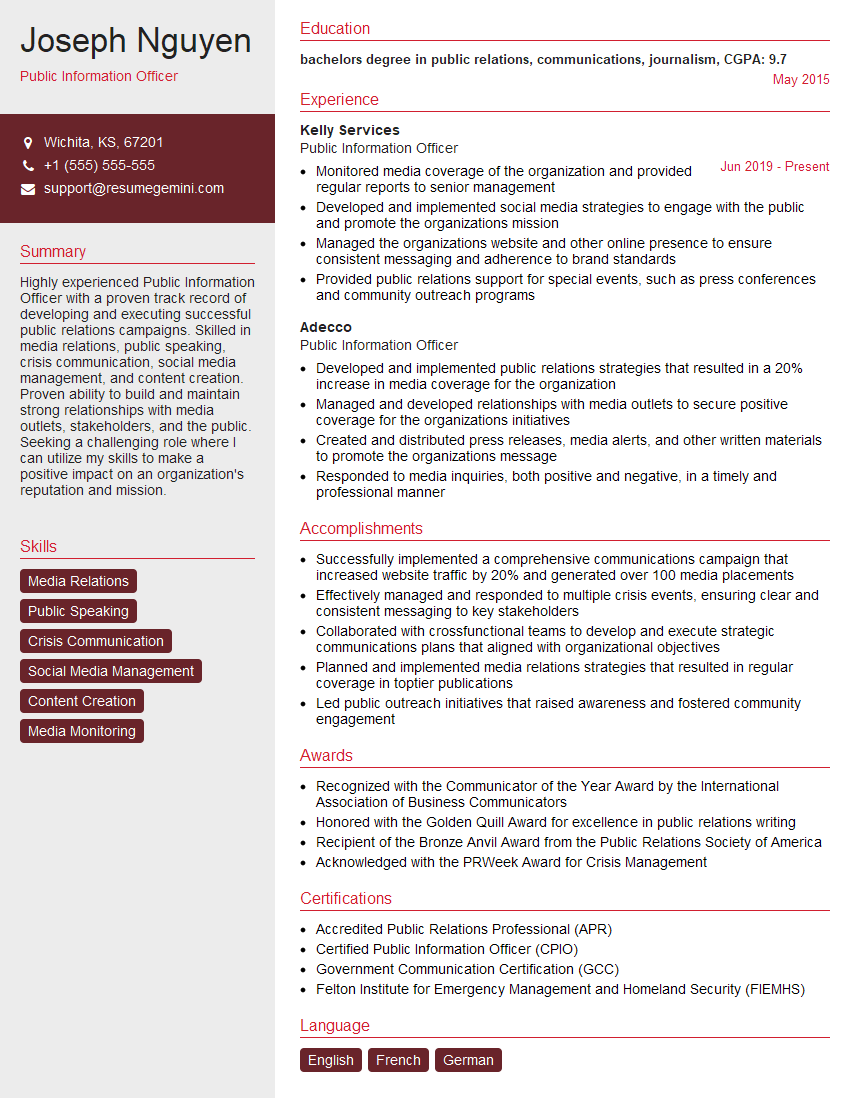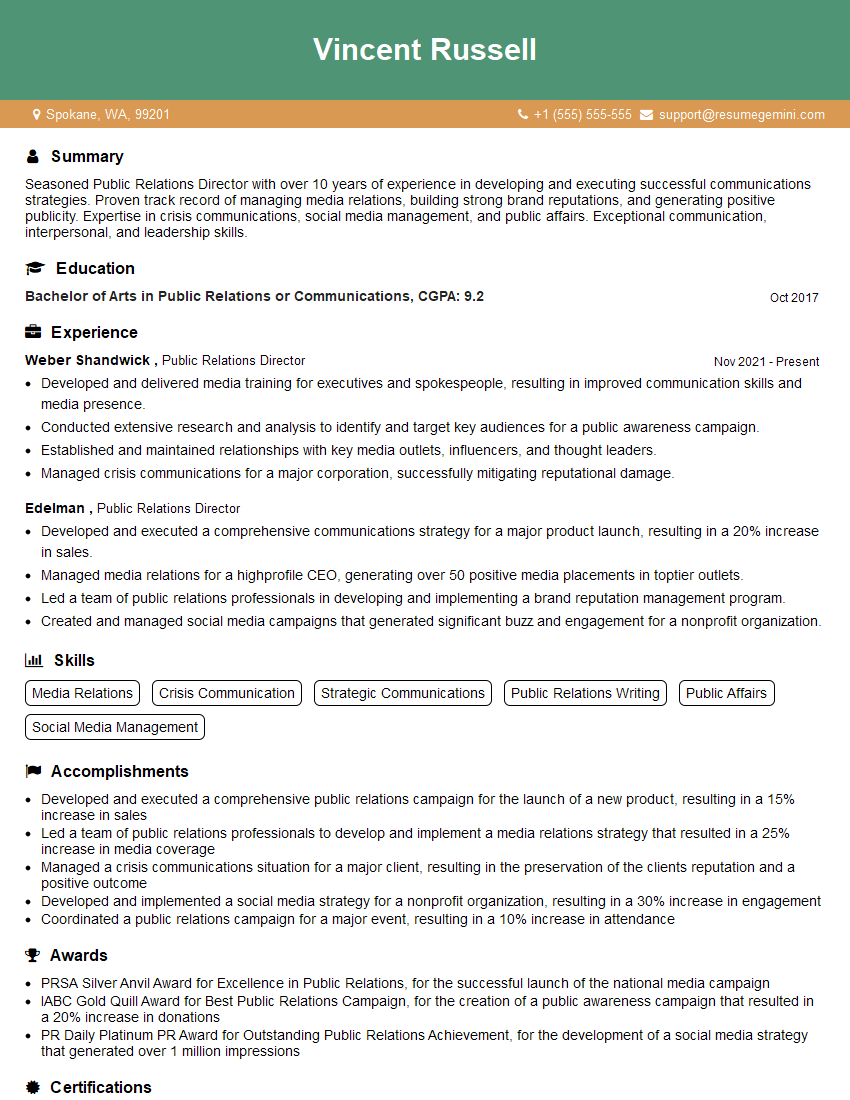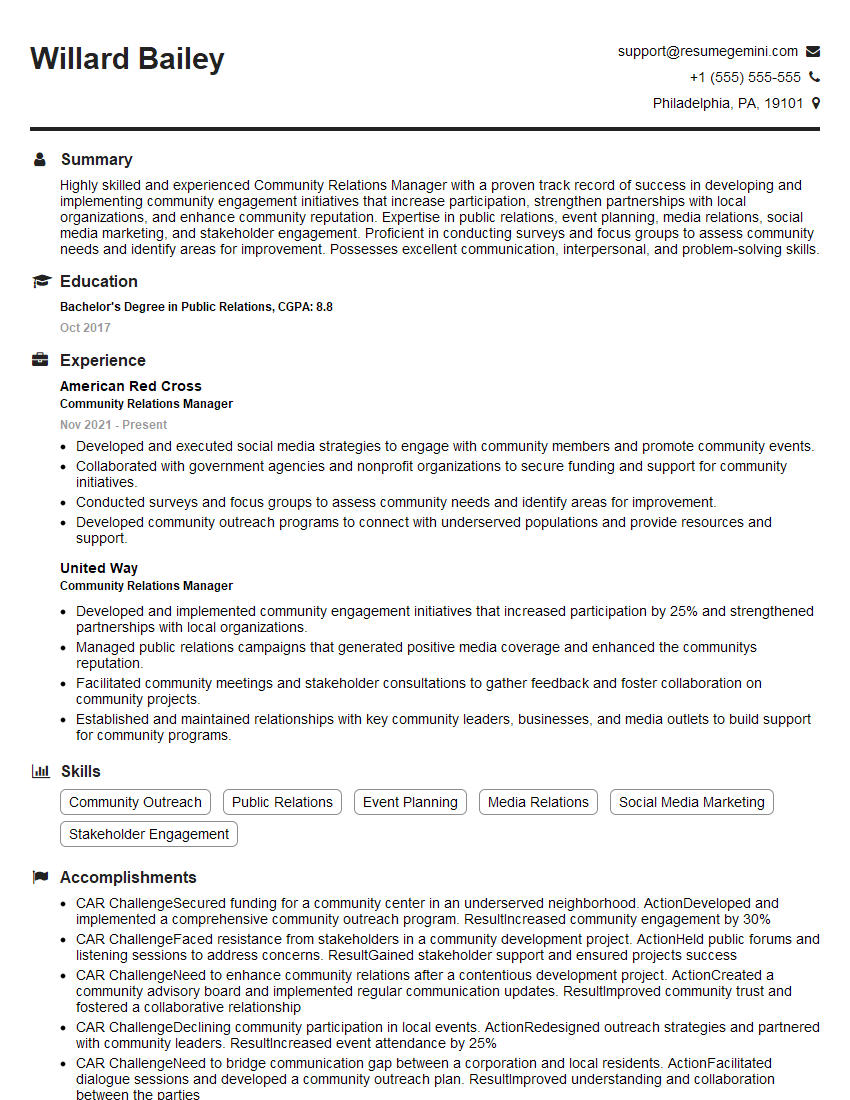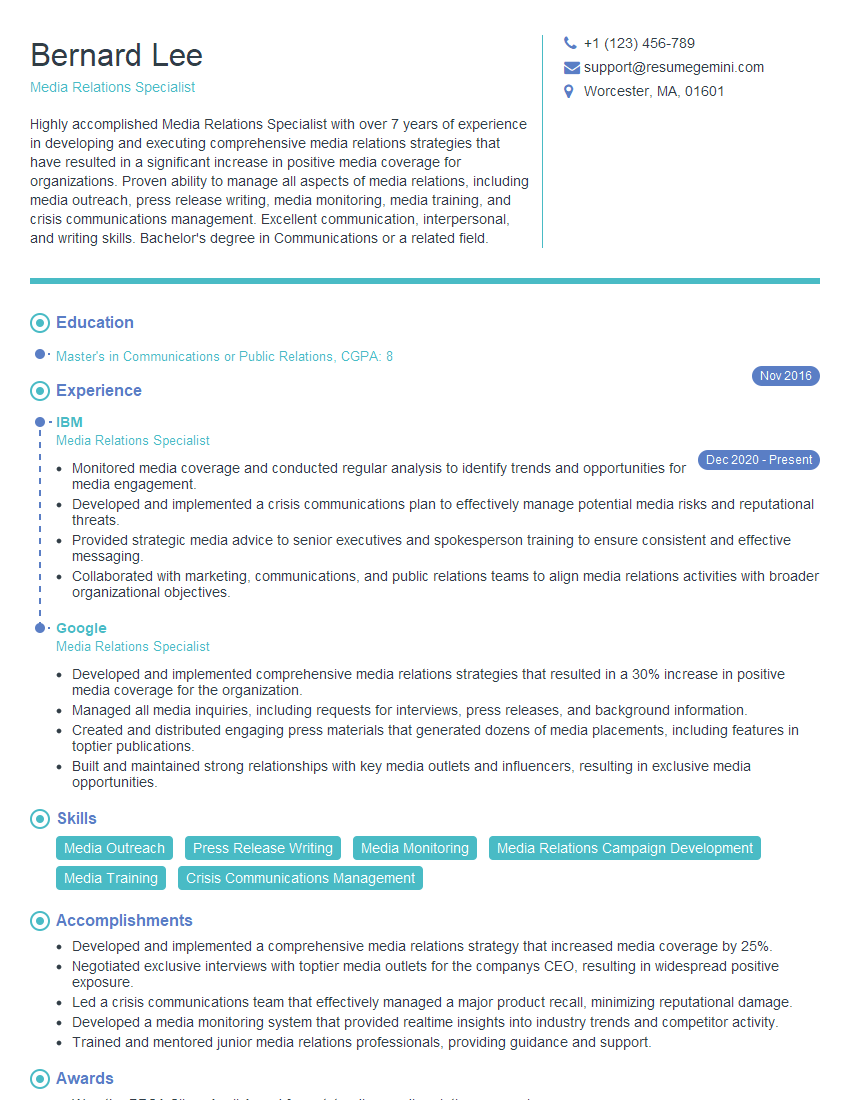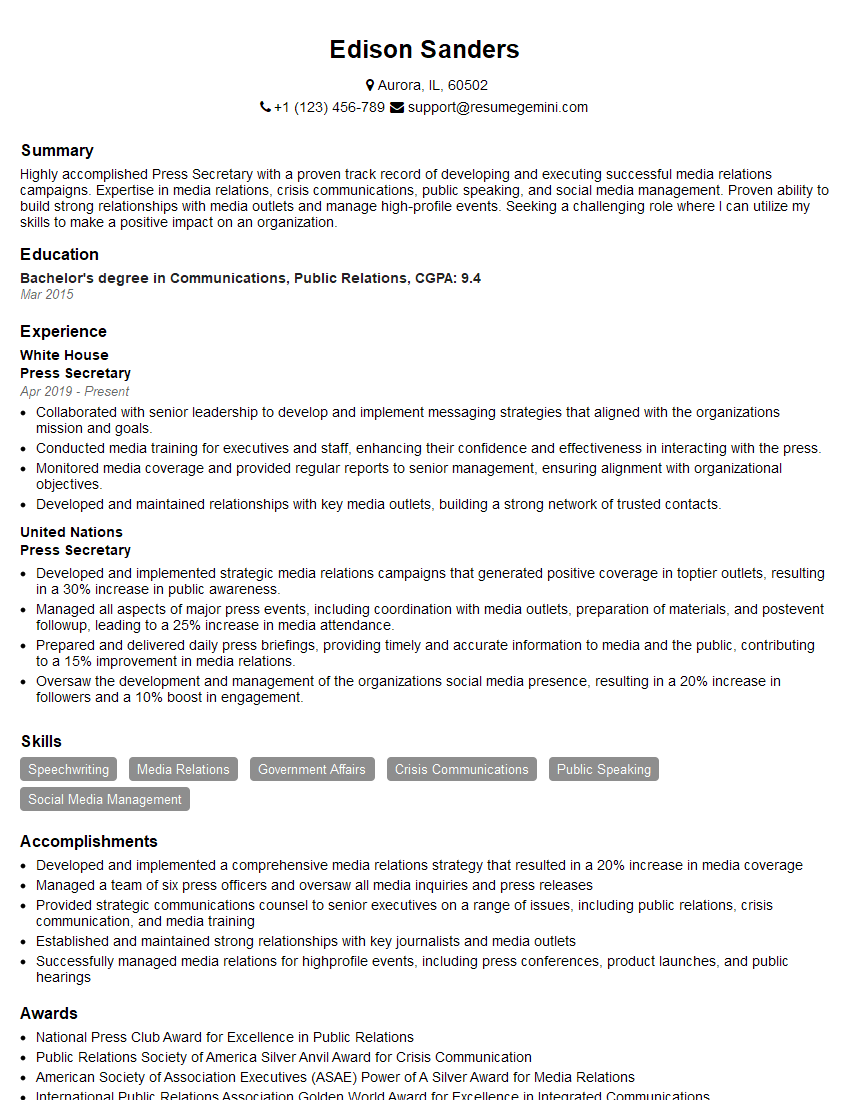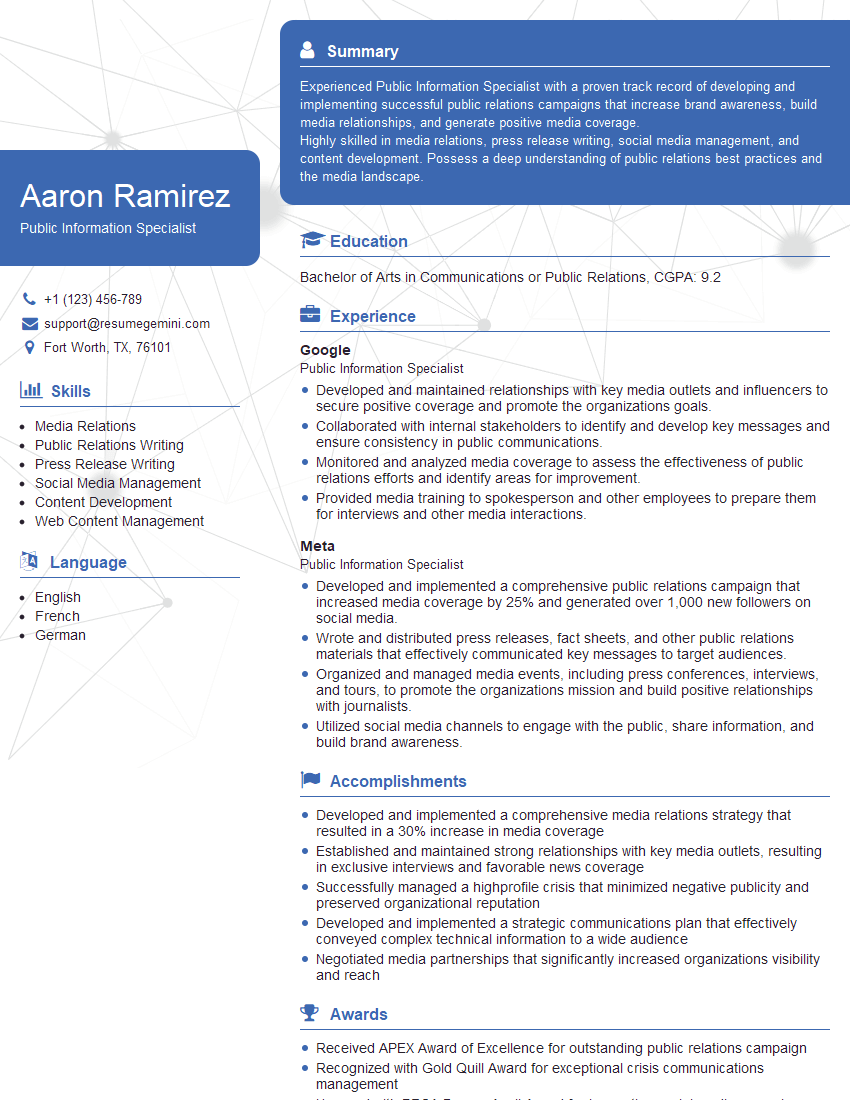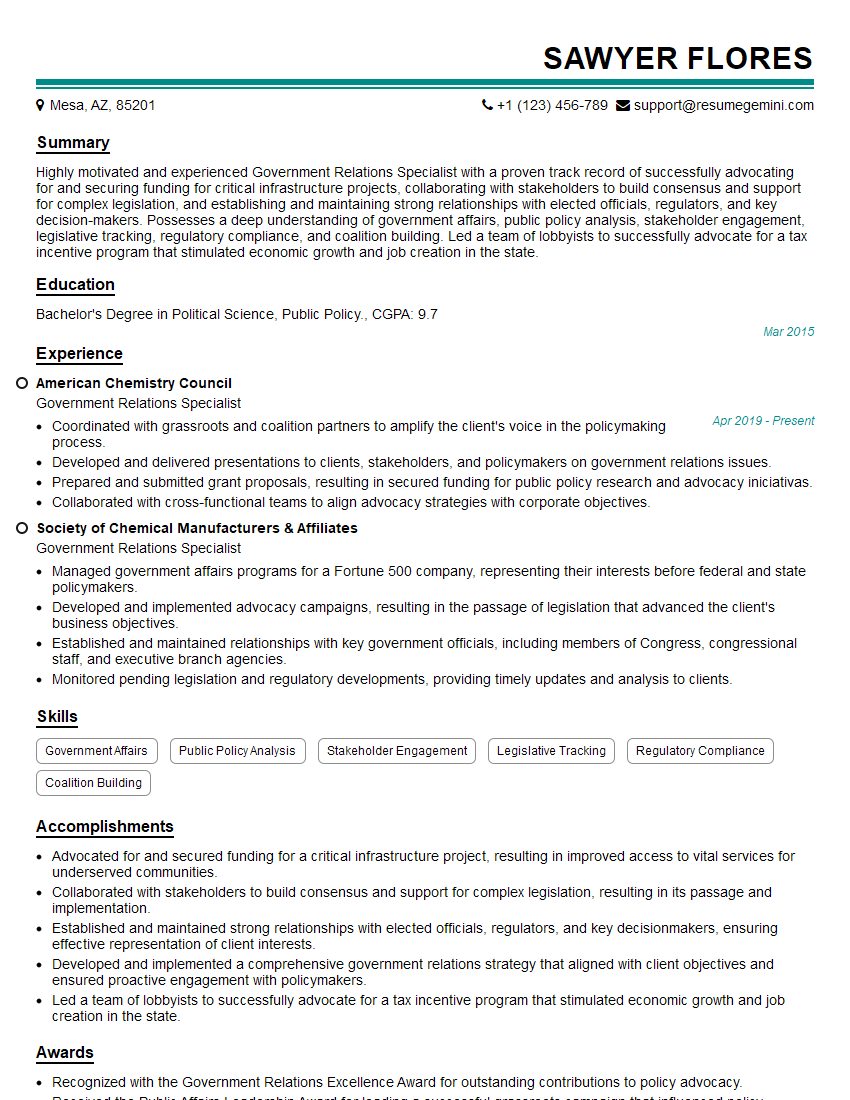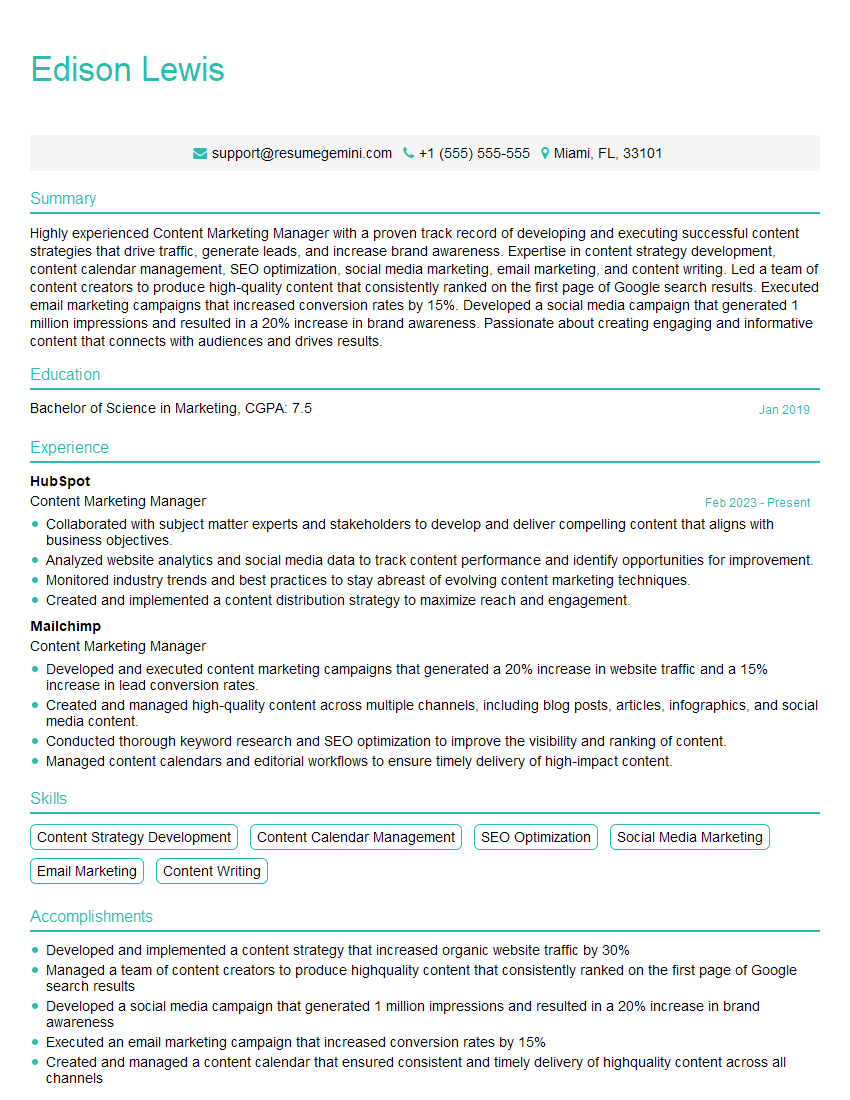The thought of an interview can be nerve-wracking, but the right preparation can make all the difference. Explore this comprehensive guide to Public Information and Media Relations interview questions and gain the confidence you need to showcase your abilities and secure the role.
Questions Asked in Public Information and Media Relations Interview
Q 1. Describe your experience crafting press releases.
Crafting effective press releases is crucial for disseminating information and shaping public perception. My process begins with a deep understanding of the key message and target audience. I then structure the release using the inverted pyramid style, placing the most important information at the beginning. This includes a compelling headline, a concise summary of the news, and supporting details. I carefully select strong quotes from relevant individuals and include all essential contact information.
For example, when announcing a new product launch for a tech company, I’d focus the headline on the key benefit to the consumer (e.g., ‘Revolutionary New App Streamlines Workflow’). The body would then detail the features, benefits, and any supporting data (like user testing results). I ensure the release is accurate, factual, and avoids jargon. Finally, I tailor the release’s distribution to the relevant media outlets, considering their audience and editorial focus.
I’ve successfully crafted press releases resulting in significant media coverage for various clients, including a non-profit’s fundraising campaign which saw a 30% increase in donations after targeted media outreach.
Q 2. How do you manage conflicting information from multiple sources?
Managing conflicting information requires a methodical approach. First, I verify the information’s source and credibility. This involves checking multiple reputable sources to ensure consistency. When inconsistencies exist, I prioritize information from trusted and authoritative sources with evidence-based claims. I cross-reference data points, looking for patterns and discrepancies. If conflicts remain, I transparently acknowledge the uncertainty, focusing on what is known with confidence while clearly stating any ongoing investigations or uncertainties.
For instance, during a product recall scenario, I might have conflicting reports about the number of affected units. I would first consult official internal records and then corroborate this information with independent testing data. I would then issue a press release that transparently addresses the range of affected products and the investigation’s progress, emphasizing steps taken to resolve the situation. Transparency is key in managing conflicting information; hiding inconsistencies only erodes trust.
Q 3. Explain your process for building and maintaining relationships with journalists.
Building and maintaining strong journalist relationships is fundamental to effective media relations. My approach involves proactive outreach, personalized communication, and consistent follow-up. I regularly pitch relevant stories to journalists, understanding their individual beats and preferences. This goes beyond simply sending press releases; I offer exclusive interviews, background briefings, and access to relevant experts. I build trust by being responsive, providing accurate information, and respecting deadlines.
For example, I might cultivate relationships with technology journalists by providing them early access to product demos or conducting exclusive interviews with my company’s CTO. I also participate in relevant industry events to network and build connections. Maintaining these relationships is an ongoing process of nurturing trust through consistent, valuable communication. I track journalist preferences using a CRM to remember their beats and previous interactions, allowing for more personalized engagement.
Q 4. How have you successfully navigated a crisis communication situation?
Navigating crisis communication requires swift, decisive action and transparent communication. During a crisis, my process involves immediately establishing a dedicated communication team, identifying key stakeholders, and assessing the situation’s scope and impact. We create a consistent message across all channels, addressing the situation honestly and directly, even if the full picture is still unfolding. We proactively monitor media coverage and social media, responding quickly to concerns and misinformation.
In one instance, a client faced a data breach. Our immediate response involved promptly notifying affected individuals, working with law enforcement, and issuing a transparent statement acknowledging the breach, outlining steps taken to contain it, and detailing the support offered to affected users. We actively engaged with media inquiries and social media comments, providing regular updates on the investigation and remediation efforts. This proactive and transparent approach helped mitigate the damage and maintain public trust.
Q 5. What metrics do you use to measure the success of a public information campaign?
Measuring the success of a public information campaign requires a multifaceted approach, combining quantitative and qualitative data. Key quantitative metrics include media mentions (measuring the number of times the campaign is covered in media), reach (the total audience reached), website traffic (measuring engagement with campaign-related materials), and social media engagement (likes, shares, comments). Qualitative metrics assess the tone of media coverage, public sentiment (through surveys or social listening), and whether the campaign achieved its stated objectives.
For example, a successful campaign to promote a new public health initiative might be measured by the number of media stories published, the increase in website traffic to relevant pages, and positive changes in public awareness and behavioral changes as measured by surveys. Ultimately, success is defined by the campaign’s impact on the intended outcomes; whether it increased awareness, changed behavior, or improved public perception.
Q 6. How do you adapt your communication style to different audiences?
Adapting communication style to different audiences is paramount. My approach involves tailoring the message’s language, tone, and delivery method to resonate with each specific audience segment. For instance, communicating with a scientific community requires precise language and a focus on data, whereas communicating with the general public may require simplifying complex concepts and using engaging storytelling techniques. I also consider the preferred communication channels for different audiences. Younger audiences may be more receptive to social media, while older audiences might prefer traditional media or print materials.
For example, when launching a new medical device, my communication to physicians would be highly technical and data-driven, emphasizing clinical trial results and technological specifications. When communicating with potential patients, I would focus on the benefits, simplifying the complex terminology and using patient testimonials to build trust and credibility.
Q 7. Describe your experience with social media management in a PR context.
Social media management is integral to modern public relations. My experience involves developing and executing social media strategies aligned with overall communication goals. This includes creating engaging content calendars, scheduling posts, monitoring social listening to understand public sentiment, and proactively engaging with audiences. I utilize social media analytics to track campaign performance, identify trends, and optimize strategies. I understand the nuances of each platform, using different content formats and styles for optimal engagement.
For instance, I might use Twitter for quick news updates, LinkedIn for professional networking and insightful articles, and Instagram for visually appealing content to reach a wider audience. Crisis management on social media requires rapid response and careful communication to address concerns and prevent misinformation from spreading. I always prioritize authenticity and transparency in all social media engagement, building trust and strengthening relationships with online audiences.
Q 8. How familiar are you with media monitoring tools and techniques?
Media monitoring is crucial for understanding public perception and managing reputation. My familiarity encompasses both the tools and the strategic application of their data. I’m proficient in using a range of tools, from basic Google Alerts to sophisticated platforms like Meltwater and Brandwatch. These tools allow me to track mentions across various media channels – news websites, blogs, social media, forums – in real-time or retrospectively. Beyond simply tracking mentions, I analyze the sentiment expressed (positive, negative, neutral), identify key themes and influencers, and ultimately use this information to inform strategic communications decisions. For instance, if a negative trend emerges in online forums, we can proactively address it before it escalates into a full-blown crisis.
My technique involves setting up tailored alerts based on keywords related to our clients or campaigns, and regularly reviewing the collected data. We then categorize and prioritize the information based on its relevance, impact, and urgency, creating actionable insights that guide our response strategies.
Q 9. How do you handle negative media coverage?
Handling negative media coverage requires a swift, strategic, and transparent approach. It’s not about ignoring the problem but about addressing it head-on. My first step is to thoroughly understand the nature of the criticism – what are the specific concerns, and who is the source? This helps us tailor our response. Next, we assess the impact of the coverage – how widespread is it, and what is the potential damage to reputation?
Our response strategy usually involves a combination of actions. This could include issuing a press release that directly addresses the concerns, engaging with commentators and critics on social media platforms, providing factual information to correct misinformation, and potentially issuing a public apology if appropriate. We also leverage positive news stories and testimonials to counter the negativity, highlighting the overall positive image of the organization. For example, if a product recall occurs, a proactive, transparent communication plan which emphasizes customer safety and shows a commitment to rectification will mitigate the damage far more effectively than silence.
Q 10. Explain your understanding of media law and ethics.
Media law and ethics are paramount in public relations. A strong understanding of libel, slander, defamation, privacy laws, and copyright is essential to ensure responsible communication. This includes knowing what constitutes a fair and accurate representation of facts, what information is privileged, and what constitutes an invasion of privacy. Ethical considerations are woven into every aspect of my work, ensuring that all communications are truthful, transparent, and responsible. For instance, we always verify information before disseminating it, and we take care to avoid misleading or manipulative language.
Ethical dilemmas can arise when dealing with sensitive information or conflicting interests. We adhere to strict codes of conduct, prioritizing transparency, fairness, and accuracy above all else. Understanding media law allows us to navigate these complexities while maintaining a strong ethical compass and protecting our clients from potential legal challenges.
Q 11. Describe your experience with media training.
My experience with media training spans several years and various sectors. I’ve designed and delivered training programs for executives, spokespeople, and other staff members on topics ranging from handling difficult interview questions to crafting compelling messages and managing social media interactions. The training focuses on practical skills, such as message development, non-verbal communication, crisis communication, and media interview techniques, employing a combination of role-playing exercises, mock interviews, and feedback sessions.
One successful example involved training a CEO who was previously uncomfortable with media interactions. Through a tailored program incorporating mock press conferences and feedback, we equipped him with the confidence and skills to effectively communicate the company’s vision and handle challenging questions from journalists. The result was an improved public image and increased trust among stakeholders.
Q 12. How would you develop a communication plan for a product launch?
Developing a communication plan for a product launch involves a phased approach. First, we define our target audience(s), identifying their needs and preferences, and the most effective channels to reach them. Next, we develop key messages emphasizing the unique selling points of the product and its benefits to the target audience. This is followed by creating a detailed timeline outlining all planned activities.
The plan would incorporate a mix of PR activities, such as press releases, media outreach, influencer marketing, social media campaigns, and potentially an event. We would also track key metrics such as media coverage, website traffic, social media engagement, and sales data to assess the effectiveness of the campaign. A thorough understanding of the product, the target audience, and the competitive landscape are key to a successful plan, and the iterative nature of such a plan means regular evaluation and adjustment based on performance are crucial.
Q 13. How do you measure the ROI of a public relations campaign?
Measuring the ROI of a PR campaign requires a multi-faceted approach that goes beyond simply counting media mentions. While media coverage is important, it’s crucial to link it to quantifiable business outcomes. We use a range of metrics, including:
- Media Impressions: Total number of people exposed to our messages.
- Sentiment Analysis: Gauging the overall positive, negative, or neutral tone of media coverage.
- Website Traffic and Leads Generated: Tracking website visits and inquiries resulting from the campaign.
- Sales Growth: Measuring the increase in sales attributable to the campaign.
- Brand Awareness and Reputation: Assessing changes in brand perception through surveys or social listening.
By tracking these metrics and attributing specific changes to the PR campaign, we can build a comprehensive picture of its impact on the bottom line. For example, we might track a rise in sales directly correlated with positive media coverage following a successful product launch. We then use this data to justify further investment in PR and to refine future campaigns.
Q 14. How do you prioritize tasks during a high-pressure situation?
Prioritizing tasks under pressure requires a structured approach. I use a combination of techniques, including:
- Identifying Critical Tasks: Determining which tasks are essential for success and have the most significant impact.
- Time Management: Allocating time to critical tasks, using tools like project management software or simple to-do lists.
- Delegation: Assigning tasks to team members when possible to maximize efficiency.
- Communication: Keeping stakeholders informed of progress and any potential challenges.
- Flexibility: Adapting plans as needed based on changing circumstances.
Imagine a scenario where a crisis erupts simultaneously with a product launch. I would immediately convene a crisis team to address the immediate situation and adjust the product launch plan accordingly, potentially postponing some aspects. Prioritization ensures resources are allocated effectively to mitigate risks and achieve the most crucial objectives.
Q 15. What is your experience with internal communications?
Internal communications is the lifeblood of any organization. It’s about fostering clear, consistent, and engaging communication within the company to ensure everyone is on the same page, aligned with goals, and feels valued. My experience spans developing and implementing comprehensive internal communication strategies across various organizational structures. This includes:
- Developing and distributing employee newsletters and announcements using various platforms, such as email, intranets, and internal social media channels.
- Creating and delivering presentations and training materials to keep employees informed on company updates, policies, and procedures.
- Managing internal communication crises, ensuring timely and accurate information reaches employees during challenging situations.
- Conducting employee surveys and feedback sessions to assess communication effectiveness and identify areas for improvement. For instance, at my previous role, we implemented an anonymous feedback system, resulting in a 20% increase in employee engagement scores within six months.
Essentially, I strive to create a culture of transparency and open communication, leading to increased employee morale, productivity, and ultimately, business success.
Career Expert Tips:
- Ace those interviews! Prepare effectively by reviewing the Top 50 Most Common Interview Questions on ResumeGemini.
- Navigate your job search with confidence! Explore a wide range of Career Tips on ResumeGemini. Learn about common challenges and recommendations to overcome them.
- Craft the perfect resume! Master the Art of Resume Writing with ResumeGemini’s guide. Showcase your unique qualifications and achievements effectively.
- Don’t miss out on holiday savings! Build your dream resume with ResumeGemini’s ATS optimized templates.
Q 16. How do you create compelling narratives for public consumption?
Creating compelling narratives for public consumption requires understanding your audience and crafting a message that resonates with their values and interests. Think of it like storytelling – you need a beginning, a middle, and an end, but it’s the emotional arc that truly captivates. My approach involves:
- Identifying the core message: What’s the single most important takeaway you want your audience to remember?
- Knowing your audience: Who are you talking to? What are their needs, concerns, and perspectives?
- Choosing the right channels: Where will your audience see and hear your message? Consider print, digital, social media, video, etc.
- Using strong visuals and storytelling techniques: Numbers are important, but stories connect with people on an emotional level. Think about using anecdotes, case studies, or even metaphors to bring your message to life. For example, when communicating the success of a new sustainability initiative, instead of simply stating the reduction in carbon emissions, I’d highlight the positive impact on the local community or the employees involved.
Ultimately, a compelling narrative is clear, concise, memorable, and emotionally resonant. It’s not just about what you say, but how you say it.
Q 17. Describe your experience working with diverse stakeholders.
Working with diverse stakeholders is fundamental to effective public information and media relations. It requires sensitivity, adaptability, and strong communication skills. My experience includes collaborating with:
- Government agencies: Navigating bureaucratic processes and building strong working relationships to ensure effective information dissemination and compliance.
- Community groups: Engaging with diverse communities to understand their needs and concerns, fostering trust and transparency.
- Media representatives: Building relationships with journalists and media outlets to ensure accurate and timely information sharing.
- Internal teams: Collaborating across departments to develop cohesive messaging and ensure consistent communication strategies.
I approach each interaction with empathy and a willingness to understand diverse perspectives. I believe that understanding different viewpoints allows for the creation of inclusive and effective communications strategies. For instance, when launching a new public health campaign targeting a multicultural community, I would ensure that all communication materials are translated into appropriate languages and reflect the cultural nuances of the target audience.
Q 18. How familiar are you with AP style?
I am very familiar with AP style. It’s the bedrock of clear, concise, and consistent writing, essential for any professional communicator. My experience includes consistently adhering to AP style guidelines in press releases, media kits, website content, and internal communications. I understand the importance of accuracy, consistency, and clarity in writing, and AP style provides a framework for achieving these goals.
Specifically, I’m proficient in:
- Proper capitalization and punctuation.
- Number style and usage.
- Date and time formatting.
- Attribution and quote usage.
- Style for titles and names.
Using AP style helps ensure that our communications maintain a professional tone and are easily understood by a wide audience.
Q 19. How do you identify key message points?
Identifying key message points is crucial for effective communication. It’s about distilling complex information into easily digestible takeaways. My approach involves:
- Understanding the objective: What are you trying to achieve with your communication? What is the desired outcome?
- Analyzing the audience: What are their interests, needs, and pre-existing knowledge?
- Prioritizing information: What are the most crucial facts and figures that need to be conveyed?
- Using a framework: I often utilize frameworks like the ‘Problem-Agitation-Solution’ (PAS) or the ‘Before-After-Bridge’ (BAB) to structure my key messages to ensure a logical flow.
- Testing and refining: Getting feedback from others and conducting A/B testing to ensure effectiveness.
For example, if communicating a new policy change, instead of overwhelming the audience with complex details, I’d focus on the three key impacts: improved efficiency, increased security, and enhanced accessibility. These become the key message points to highlight.
Q 20. How do you use data to inform your communication strategies?
Data plays a critical role in informing effective communication strategies. It allows us to move beyond intuition and make data-driven decisions. I use data in several ways:
- Audience analysis: Understanding demographics, media consumption habits, and online behavior helps tailor messages for maximum impact. For example, analyzing website analytics allows me to see what content resonates most with our audiences and refine our content strategy accordingly.
- Campaign measurement: Tracking key metrics like website traffic, social media engagement, and media coverage enables evaluation of campaign effectiveness and identifies areas for improvement.
- Trend identification: Analyzing data on public opinion and social media sentiment helps anticipate potential challenges and adapt communication strategies proactively.
- Reporting and ROI demonstration: Data provides concrete evidence of the impact of communication efforts, demonstrating return on investment to stakeholders.
Using data allows me to build a compelling case for strategic decisions and ultimately leads to more efficient and impactful communication campaigns.
Q 21. Describe your experience with budget management in a communications role.
Budget management is an integral part of my role. I’m experienced in developing and managing budgets for various communication projects, ranging from small-scale internal initiatives to large-scale public awareness campaigns. This involves:
- Budget planning and development: Creating detailed budget proposals outlining anticipated expenses, including personnel costs, media buys, printing, event planning, and digital marketing.
- Expense tracking and monitoring: Closely monitoring expenses to ensure adherence to the approved budget and identifying any potential cost overruns.
- Resource allocation: Strategic allocation of budget funds across different communication channels and activities to maximize impact and efficiency.
- Reporting and justification: Regularly reporting on budget expenditures to stakeholders and providing justifications for spending decisions.
I utilize budgeting software and best practices to ensure transparency, accountability, and responsible use of resources. My goal is always to achieve maximum impact within the allocated budget.
Q 22. How do you build trust and credibility with the media?
Building trust and credibility with the media is paramount in public relations. It’s about establishing a reputation for honesty, transparency, and reliability. This isn’t a one-time effort; it’s an ongoing process built on consistent actions.
- Proactive Communication: Regularly sharing relevant information, even if it’s not immediately newsworthy, keeps you top-of-mind and demonstrates transparency. For example, providing regular updates on a company’s sustainability initiatives builds trust.
- Accuracy and Fact-Checking: Always ensure the information you provide is accurate and well-sourced. Errors erode trust quickly. Internal fact-checking processes and multiple review stages are crucial.
- Responsiveness: Return calls and emails promptly. Ignoring media inquiries breeds suspicion and makes it harder to build relationships.
- Relationship Building: Cultivate relationships with journalists by understanding their beats and providing them with valuable information relevant to their areas of interest. This involves attending industry events and networking.
- Transparency and Honesty: Be upfront about challenges or difficult situations. Don’t try to hide negative information; address it head-on, showing a commitment to accountability.
Think of it like building a personal relationship: trust is earned over time through consistent positive interactions and open communication.
Q 23. What is your experience with reputation management?
Reputation management is a crucial aspect of my work. It’s about proactively protecting and enhancing an organization’s image and responding effectively to crises. My experience involves:
- Monitoring Online Reputation: Utilizing social listening tools to track brand mentions, sentiment, and potential reputational threats. This allows for swift response to negative feedback.
- Crisis Communication Planning: Developing comprehensive crisis communication plans to address potential reputational damage. These plans outline key messages, spokesperson roles, and communication channels.
- Strategic Communication: Crafting strategic communications to counter negative narratives and rebuild trust. This often involves proactive outreach to key media outlets and influencers.
- Social Media Management: Engaging with stakeholders on social media platforms, addressing concerns, and promoting positive narratives. This requires careful monitoring and a quick response time to address issues effectively.
- Damage Control: Developing and implementing strategies to mitigate reputational damage following a negative event. This might involve issuing public apologies, correcting misinformation, or engaging with affected parties.
For example, I recently helped a client navigate a product recall by proactively communicating with the media and affected consumers, mitigating the potential for significant reputational damage.
Q 24. How do you handle interviews with hostile or skeptical journalists?
Handling interviews with hostile or skeptical journalists requires preparation, composure, and a strategic approach.
- Preparation: Anticipate potential difficult questions and prepare concise, factual answers. Role-playing can be incredibly helpful.
- Stay Calm and Respectful: Maintain composure, even when faced with aggressive questioning. Avoid getting defensive or emotional.
- Bridge the Gap: Acknowledge the journalist’s concerns and attempt to bridge the gap between their perspective and your organization’s position. For example, ‘I understand your concern about X, and while that’s a valid point, our approach focuses on Y…’
- Stick to the Facts: Focus on providing factual information and avoid speculation. If you don’t know the answer, admit it and promise to follow up.
- Reframe the Narrative: If possible, use the opportunity to subtly shift the focus to your key messages, even if it’s indirectly addressing the question.
Remember, the goal isn’t always to win the argument but to convey your key messages effectively and maintain professionalism.
Q 25. How do you ensure consistent messaging across various channels?
Consistent messaging across channels is vital for building a cohesive brand image and avoiding confusion. This involves:
- Centralized Messaging Platform: Utilizing a central repository for all key messages, ensuring everyone is on the same page. This could be a shared document, internal wiki, or communication platform.
- Style Guide: Developing and adhering to a brand style guide that dictates tone, voice, and terminology across all communications.
- Internal Communication: Ensuring internal stakeholders understand and support the key messages before engaging with external audiences. This often involves training sessions and regular updates.
- Review and Approval Process: Implementing a review and approval process for all communications materials to ensure consistency in messaging and brand voice.
- Regular Monitoring: Tracking the performance and impact of messaging across different channels, allowing for necessary adjustments and improvements.
A well-defined messaging framework prevents conflicting information, strengthens brand identity, and creates a more impactful communication campaign.
Q 26. Describe your experience using analytics to track campaign performance.
I have extensive experience using analytics to track campaign performance. This includes:
- Media Monitoring Tools: Using tools like Cision or Meltwater to track media mentions, sentiment analysis, and reach.
- Website Analytics: Utilizing Google Analytics to track website traffic, engagement, and conversions from PR efforts.
- Social Media Analytics: Tracking social media engagement, reach, and sentiment to measure the impact of social media campaigns.
- Share of Voice Analysis: Measuring the organization’s share of voice in relevant media conversations.
- Return on Investment (ROI): Calculating the ROI of PR campaigns by comparing the cost of the campaign to the value generated through increased brand awareness, lead generation, or sales.
By analyzing this data, I can identify what’s working, what’s not, and make data-driven decisions to optimize future campaigns. For example, tracking website traffic from specific media mentions can demonstrate the direct impact of PR efforts.
Q 27. Explain your understanding of SEO and its relevance to PR.
SEO, or Search Engine Optimization, is increasingly relevant to PR because it helps to improve the visibility of an organization’s online content and ultimately, its reach.
- Keyword Research: Identifying relevant keywords that journalists and the target audience are searching for. This informs content creation and media outreach strategies.
- Content Optimization: Creating high-quality, keyword-rich content that is optimized for search engines. This includes press releases, blog posts, and website content.
- Link Building: Securing high-quality backlinks from reputable websites to improve website authority and search engine rankings. This is often achieved through media outreach and securing mentions.
- On-Page Optimization: Optimizing website content, meta descriptions, and title tags to improve search engine visibility.
- Off-Page Optimization: Building brand awareness and authority through external factors like social media and media relations.
By integrating SEO strategies into PR campaigns, organizations can significantly extend their reach and achieve greater visibility for their key messages.
Q 28. How familiar are you with different types of media outlets and their target audiences?
I am familiar with a wide range of media outlets, including:
- Traditional Media: Newspapers, magazines, television, and radio. I understand the different editorial styles and target audiences of each.
- Digital Media: Blogs, websites, online news publications, social media platforms, and podcasts. I’m adept at identifying influencers and tailoring messages for these platforms.
- Trade Publications: Specialized publications that cater to specific industries. Understanding these publications is critical for targeting niche audiences.
- Broadcast Media: Television and radio news channels, understanding their news cycles and preferred formats for contributions.
My understanding of these different outlets and their audiences informs my media strategy, ensuring that messages are tailored to resonate with the specific target audience of each.
Key Topics to Learn for Public Information and Media Relations Interview
- Crisis Communication: Understanding crisis communication strategies, including proactive planning, rapid response protocols, and media engagement during sensitive situations. Practical application: Developing a crisis communication plan for a hypothetical scenario involving a public health emergency.
- Media Pitching & Relationship Building: Mastering the art of crafting compelling press releases, pitching stories to journalists, and building strong, long-term relationships with media outlets. Practical application: Developing a media pitch for a new community initiative and anticipating potential journalist questions.
- Public Opinion & Social Media: Analyzing public sentiment, utilizing social media for communication and engagement, and understanding the ethical considerations of digital media relations. Practical application: Designing a social media strategy to address public concerns about a controversial topic.
- Strategic Communication Planning: Developing comprehensive communication plans aligned with organizational goals, understanding target audiences, and measuring the effectiveness of communication efforts. Practical application: Creating a communication plan for a product launch, highlighting key messages and target demographics.
- Message Crafting & Storytelling: Writing clear, concise, and engaging messages tailored to different audiences, leveraging storytelling techniques to connect with the public and build trust. Practical application: Crafting a compelling narrative to highlight an organization’s achievements and values.
- Media Training & Interview Techniques: Preparing spokespeople for media interviews, coaching them on effective messaging and handling challenging questions. Practical application: Developing a media training program for employees who may be called upon to interact with the press.
- Legal & Ethical Considerations: Understanding legal and ethical guidelines related to public information dissemination, including freedom of information laws and media ethics. Practical application: Identifying potential legal and ethical challenges in a hypothetical public relations scenario.
Next Steps
Mastering Public Information and Media Relations is crucial for career advancement in today’s dynamic communication landscape. It opens doors to influential roles where you can shape public perception, build strong organizational reputations, and navigate complex communication challenges. To significantly boost your job prospects, focus on creating an ATS-friendly resume that highlights your skills and experience effectively. We strongly recommend using ResumeGemini to craft a professional and impactful resume. ResumeGemini provides the tools and resources to build a compelling resume, and examples of resumes tailored to Public Information and Media Relations are available to guide you.
Explore more articles
Users Rating of Our Blogs
Share Your Experience
We value your feedback! Please rate our content and share your thoughts (optional).
What Readers Say About Our Blog
Interesting Article, I liked the depth of knowledge you’ve shared.
Helpful, thanks for sharing.
Hi, I represent a social media marketing agency and liked your blog
Hi, I represent an SEO company that specialises in getting you AI citations and higher rankings on Google. I’d like to offer you a 100% free SEO audit for your website. Would you be interested?
